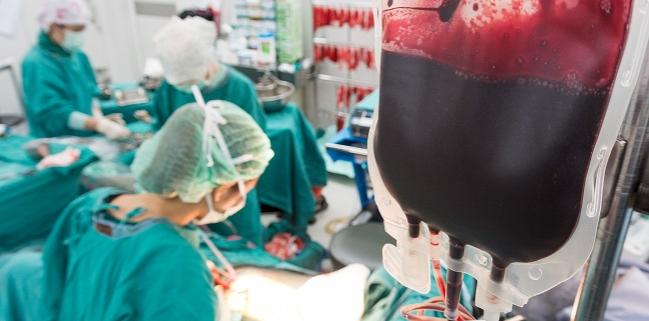Bleeding, Myocardial Injury Are Key Drivers of Deaths After Noncardiac Surgery
Venous events are no longer as important as arterial deaths, and these should be the focus for reducing post-op surgical risk.

Major bleeding, myocardial injury, and sepsis are the three biggest drivers of mortality after noncardiac surgery, accounting for roughly 45% of these deaths, according to the Vascular Events in Noncardiac Surgery Patients Cohort Evaluation (VISION) study. But deaths are rare and the vast majority occur in the postoperative period, investigators say.
“Most people have a tendency to believe that it’s venous events that kill patients around the time of surgery,” said lead investigator P.J. Devereaux, MD, PhD (Population Health Research Institute, Hamilton, Canada). “If you get a pulmonary embolism, it can kill you. But what the research shows dramatically is that, in contrast with 30 years ago, the venous events are now accounting for very few events. The arterial events, the bleeding events, and the sepsis events are what are driving a lot of deaths. If we want to drop mortality in the surgical setting in the coming decade, that’s what we need to focus on.”
To TCTMD, Devereaux said the last several decades have seen advances in perioperative care, including less-invasive surgery, improved anesthesia, enhanced interoperative monitoring, and greater mobilization after the procedure, but that there haven’t been any large international studies examining the incidence of mortality after modern-day surgery. Additionally, patients undergoing surgery today are older and have more comorbidities than in the past. For this reason, the researchers sought to assess the incidence of death after noncardiac surgery, as well as the timing and causes of death.
Where we have failed patients is in postoperative care. P.J. Devereaux
The study, which was published July 29, 2019, in CMAJ, includes 40,004 patients aged 45 years and older who underwent inpatient noncardiac surgery at 28 hospitals in 14 countries between 2007 and 2013. Overall, 19.9% of patients underwent major general surgery, 17.5% major orthopedic surgery, and 12.1% major urology and gynecology surgery. A little more than one-third had a low-risk operation, while 6.6%, 5.9%, and 2.9% underwent major vascular surgery, major neurosurgery, and major thoracic surgery. General anesthesia was used in 51.9% of procedures.
While 715 patients (1.8%) died within 30 days of surgery, just five deaths occurred in the operating room. Of the remaining events, 500 patients (69.9%) died after surgery during the index admission to hospital and 210 patients (29.4%) died after discharge from hospital but within the 30-day period.
“People are always waiting anxiously for the surgeon to come to the recovery room to tell families if their loved one made it through surgery,” said Devereaux, noting that such concern is even captured in movies and television. “The reality is that surgery is actually the safest period now. Of those that are going to die, 99.3% are going to die after the OR, and that’s a credit to what’s happened with anesthetists and surgeons—they’ve made the intraoperative setting extremely safe. Where we have failed patients is in postoperative care.”
Better Monitoring and Management After Surgery
In total, eight complications were independently associated with death at 30 days, including major bleeding, myocardial injury after noncardiac surgery, sepsis, acute kidney injury with dialysis, stroke, venous thromboembolism, congestive heart failure, and new, clinically-important atrial fibrillation. Major bleeding, myocardial injury, and sepsis were the three largest drivers of mortality, with these complications having the highest attributable fractions of risk of death.
Myocardial injury is largely the result of supply-demand mismatch during surgery, said Devereaux, noting that major operations can trigger procoagulant and proinflammatory pathways that cause thrombotic events. In 2017, the VISION investigators reported that elevations in peak high-sensitivity troponin T (hs-cTnT) levels correlated strongly with 30-day mortality and may explain roughly one-quarter of deaths following noncardiac surgery. Because myocardial injury is mostly asymptomatic, the study suggested that measuring hs-cTnT might be a way to identify at-risk patients. In 2018, the same investigators reported data suggesting that use of dabigatran (Pradaxa; Boehringer Ingelheim) in patients with myocardial injury after noncardiac surgery reduced the risk of major arterial and venous complications.
Researchers, led by Devereaux, are currently conducting the POISE-3 study, a 10,000-patient randomized controlled trial with the primary objective of testing tranexamic acid for the prevention of life-threatening, major, and critical organ bleeding in the 30 days following noncardiac surgery.
In terms of patient care, Devereaux pointed out that patients now go home sooner after surgery, and while that is likely an advantage over a prolonged hospital stay, there is a need for better monitoring and management strategies as patients are transitioned from the hospital to the home. For example, many patients are treated with analgesics after surgery that can mask symptoms of complications, such as chest pain, but do not receive follow-up care 3 to 4 weeks later in the physician’s office.
“Our goal should be that it doesn’t matter how old you are, or what kind of comorbidity you have, we can deliver surgery safely,” said Devereaux. “We should never lose sight of the fact people are getting surgery for very important reasons. Our goal has to be how to make that safe so that you can get the benefits of the surgery and we’ll do our job to make sure there are no complications, or if there are complications, they are recognized and treated well so that it doesn’t become a big problem. That, I’m hopeful for.”
Michael O’Riordan is the Managing Editor for TCTMD. He completed his undergraduate degrees at Queen’s University in Kingston, ON, and…
Read Full BioSources
The Vascular Events in Noncardiac Surgery Patients Cohort Evaluation (VISION) study investigators. Association between complications and death within 30 days after noncardiac surgery. CMAJ. 2019;191:E830-837.
Disclosures
- Devereaux reports participating in advisory board meetings for GlaxoSmithKline and Boehringer Ingelheim. He also reports attending expert panel meetings with AstraZeneca and Boehringer Ingelheim.


Comments